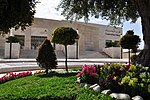Dheisheh

Dheisheh (Arabic: مخيم الدهيشة) is a Palestinian refugee camp located just south of Bethlehem in the West Bank. Dheisheh was established in 1949 on 0.31 square kilometers of land leased from the Jordanian government. The camp was established as a temporary refuge for 3,400 Palestinians from 45 villages west of Jerusalem and Hebron who fled during the 1948 Arab–Israeli War. The camp had a population of 8,805 in 2017.Six decades of natural population growth have expanded the camp's dimensions into an area between 1 and 1.5 square kilometers. The exact dimensions are subject to periodic debate between residents, UNRWA and the Palestinian Authority. The latter two are required to provide services to residents, depending on their resident status within the camp. Although initially living in tents, the residents have since constructed homes. Many streets are now paved, while still remaining very narrow. According to UNRWA, the entire camp is connected to the municipal water and electric systems of Bethlehem, yet 15% of the camp remains unconnected to the local public sewage system. These homes make use of communal percolation pits.
Excerpt from the Wikipedia article Dheisheh (License: CC BY-SA 3.0, Authors, Images).Dheisheh
Dheisheh Main, Bethlehem
Geographical coordinates (GPS) Address Nearby Places Show on map
Geographical coordinates (GPS)
| Latitude | Longitude |
|---|---|
| N 31.693888888889 ° | E 35.184166666667 ° |
Address
Dheisheh main
Dheisheh Main
Bethlehem
Palestinian Territories
Open on Google Maps






